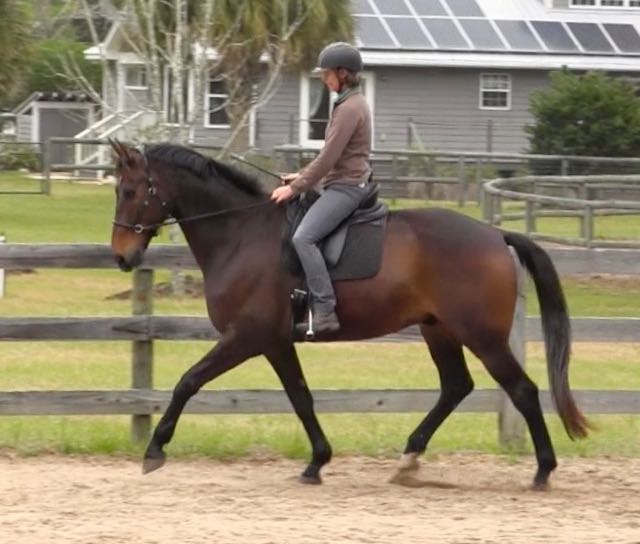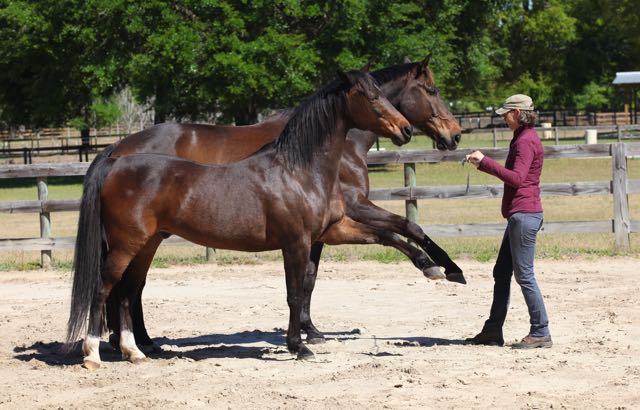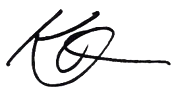
Rehabilitating a horse can be one of the most rewarding experiences.
The horses I have returned to wholeness have taught me valuable lessons that have benefited all my horses. I have rehabilitated several horses who came to me with 'undiagnosable' lamenesses. Most often they had combinations of mental, emotional, and physical issues that needed to be unwound. Students of my programs also have reported great success. To be successful, however, requires being committed to the process without being attached to the outcome.
The key is to focus on what your horse CAN do, and strengthen that in as many ways as possible. This will give you the necessary hopefulness and positivity while still keeping firmly grounded in reality.
Below are some guidelines for each of the 3 pillars of recovery: Partnership (lifestyle, mental/emotional well-being), Biomechanics (ease of movement), Gymnastics (strengthening the place of ease)
My personal experience is with equine athletes who were mentally shut down, had un-solvable lamenesses, or both.
Key Considerations:
Partnership
- Wait and watch. Don’t jump in too fast. Give the horse time to feel safe with you.
- Diagnostics. Understand any existing injuries or afflictions
- Help him feel safe - Meet him where he is. Dramatic changes can be traumatic. Ease him into his new healthy lifestyle. For example, a horse who has been alone and stalled may initially become stressed if thrown out in a big herd 24/7.
- Basic needs: Freedom, Forage, and Friends. Many training and health problems have been solved simply by getting horses back to a more natural lifestyle.
- Nurture curiosity, give him choices. Beware of learned helplessness. You’ll want your horse to work with you. For this, he has to feel free to make choices and express what he wants or needs.
Biomechanics
- Solve communication issues that lead to brace or contortion. Many mental, emotional, and physical injuries can be traced to conflicting aids and/or confusion.
- Dissolve negative tension: In my Moving Massage technique, you dissolve excess muscle tension through gentle touch while walking next to your horse.
- Find The Sweet Spot: Experiment to find the place of ease of movement. I call this the Finding The Sweet Spot of Healthy Biomechanics technique. Play with different energies and balance to find where he feels the most comfortable, relaxed, free, and even. For example, with a horse who had adhesions that caused one leg to move short, I shortened the stride in general to match the short-moving leg. This created evenness, ease, and symmetry we could build on.
Gymnastics
- Do what he CAN do. For example, with a horse who had a 'mysterious lameness' only when going track right: I exercised him on straight lines and turns to the left only. Taking this time built his trust in me and his own body. He eventually told me when he was ready to do more (and within 3 weeks was sound). For a horse with a front end lameness, I taught school halts where the horse ‘sits’ on his hindquarters and posture exercises while he was recovering.
- Strengthen the place of ease. When you find your Sweet Spot of movement, strengthen it. If you do this wisely, dressage is physical therapy.
This process is no different from what I do with ALL horses.
When you are able to rehabilitate a horse it feels like a gift. Then again, every day with every horse is a gift!
Photo Notes: Top picture is Hot Shot, a professionally trained warmblood who was given to me on his way to being retired at age 7 due to an unsolvable lameness. He was also mentally defensive and braced and afraid to be turned out for more than 45 minutes. At the time of writing this article he lives turned out in a herd 24/7 and is happily playing with Fourth Level and beyond. The other horse pictured is Atomic, one of his herd-mates.
Thoughts? Scroll down to leave a comment!




